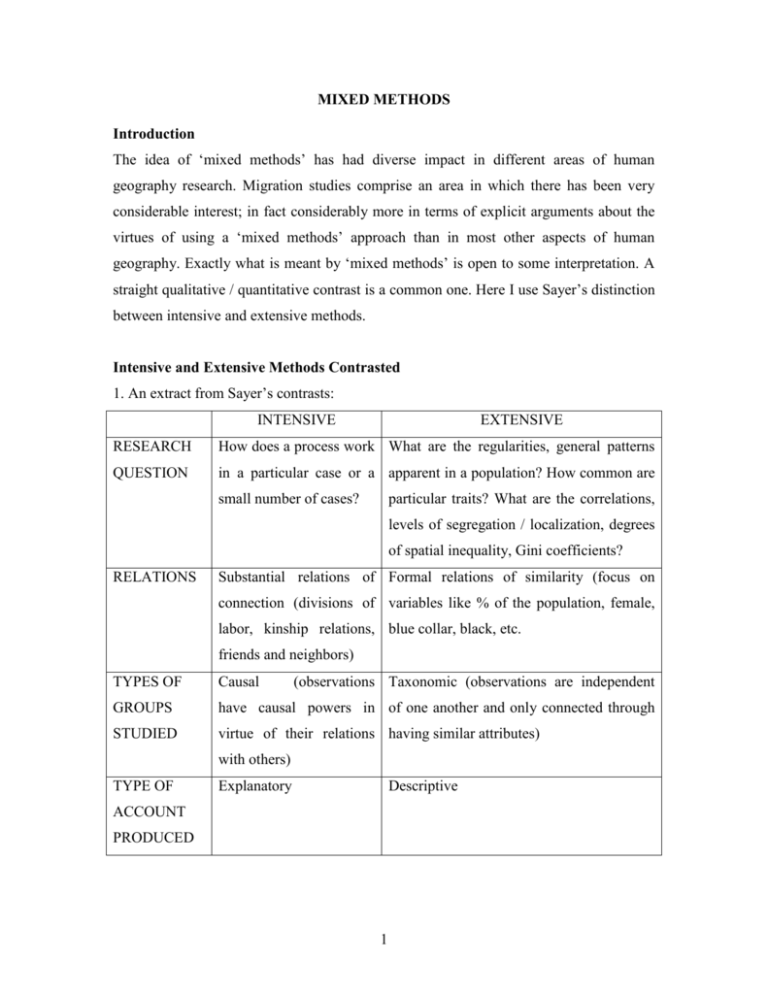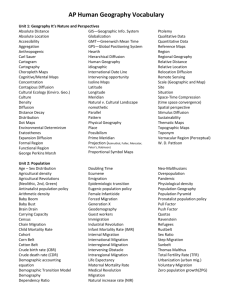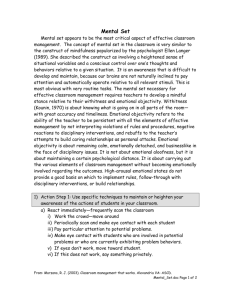9 - The Ohio State University
advertisement

MIXED METHODS Introduction The idea of ‘mixed methods’ has had diverse impact in different areas of human geography research. Migration studies comprise an area in which there has been very considerable interest; in fact considerably more in terms of explicit arguments about the virtues of using a ‘mixed methods’ approach than in most other aspects of human geography. Exactly what is meant by ‘mixed methods’ is open to some interpretation. A straight qualitative / quantitative contrast is a common one. Here I use Sayer’s distinction between intensive and extensive methods. Intensive and Extensive Methods Contrasted 1. An extract from Sayer’s contrasts: INTENSIVE EXTENSIVE RESEARCH How does a process work What are the regularities, general patterns QUESTION in a particular case or a apparent in a population? How common are small number of cases? particular traits? What are the correlations, levels of segregation / localization, degrees of spatial inequality, Gini coefficients? RELATIONS Substantial relations of Formal relations of similarity (focus on connection (divisions of variables like % of the population, female, labor, kinship relations, blue collar, black, etc. friends and neighbors) TYPES OF Causal (observations Taxonomic (observations are independent GROUPS have causal powers in of one another and only connected through STUDIED virtue of their relations having similar attributes) with others) TYPE OF Explanatory Descriptive ACCOUNT PRODUCED 1 The descriptive role of extensive methods has been noted by others. According to McLafferty: “Quantitative methods have a place in geographic research, a place that should be circumscribed not by technocratic goals, but by their appropriateness for analyzing gender disparities at different scales and in different socio-spatial contexts.” Lawson makes a similar statement: “ … for researchers employing a relational ontology and focusing on questions of process, counting can only be descriptive of carefully contextualized relations” (p.454) (my emphasis) Nevertheless, the contrasts could do with a bit of softening in a number of different respects: Extensive research deals at least occasionally with relations of substantive connection, and in a way designed to shed light on causation. Some quantitative work deals with the relations of places over space, through trade, migration, movement of capital, and the difference those movements make to the attributes of the place. Brian Robson’s work on attitudes to education is designed precisely to illuminate social connections of a causally significant type: relations inside and outside the neighborhood. Another example concerns work on migration from mining villages in County Durham in England.1 This was work that employed both structured questionnaires and unstructured interviews addressed to those who had migrated and those who had stayed behind; the purpose of the latter was to corroborate the causal nature of the relations identified by the responses to the questionnaires. Some of the questions in the structured interviews probed the relative embeddedness of respondents: “Migrants are clearly less indigenous than are non-migrants. The migrant husband, his parents and his grandparents are all less likely to have been born in the village than is the non-migrant and his forbears” (p.110). And: “There are also significant differences in the location of siblings. Migrant households are less likely to have brothers and sisters in the village than are non-migrants, and are more likely to have siblings outside County Durham” (p.111). The author notes the obvious implication of this in terms of the absence of some emotional attachment but then R C Taylor (1969) “Migration and Motivation: A Study of Determinants and Types.” Chapter 5 in J A Jackson (ed.), Migration. Cambridge: Cambridge University Press. 1 2 adds: “The fact that the migrants themselves, their siblings, parents and grandparents are all less likely to have lived in the village, and more likely to have lived outside County Durham than are non-migrants and their kin, suggests that propensity to migrate may be a family, rather than an individual characteristic … The presence in many migrant families of a precedent conceivably makes migration more of a reality and perhaps more important, provides a regular and reliable source of information on opportunities in other areas” (p.111). Similarly a good deal of intensive research aims to make general statements. The work of the Bertaux on the traditional bakery is clearly meant to come to conclusions about its persistence in France as a whole, as in their use of the concept of ‘saturation of knowledge.’ Although it is not clear from their article, one assumes that given the tone of their discussion, bakers and their apprentices were interviewed at a variety of different sites in France. The work that Andy Wood and I did on the local development network likewise aimed at generality across the metropolitan areas of Ohio. Any work rooted in some cross-national contrast would also have to have a generalizing element. There is another sense in which extensive methods are not necessarily nonexplanatory. When we think of extensive methods we are likely to have in mind the calculation of descriptive statistics like correlation coefficients, variances or principle components. However, something like Hagerstrand’s Monte Carlo simulation has clear explanatory intent and of a very general nature. In his classic study Migration and Area, Hagerstrand points out the presence in migration patterns of what he calls ‘deviations from the distance decay rule.’ These are cases where migrants from a particular area of origin are very underpredicted by a gravity model: there are far more migrants than one would expect given the distance over which they are migrating and the size of the population at the area of origin. He then speculates on a mechanism for this: that for quite chance reasons people from a particular area can find themselves a long way from home, doing military service, on a long term contract with a firm from their home area, etc. Perhaps they get married and stay 3 there. They then serve as a conduit of information, help in the job market for others from the home area. Some arrive and likewise serve as conduits for others. And so the process acquires a cumulative character. The question is: Could such a process produce the sorts of patterns that he had observed? In order to find out he simulated migration patterns using various rules for allocating migrants to places of destination. Thus: i) the initial distribution of migrants to places of destination was according to probabilities derived from a gravity model: higher probability for closer destinations, lower probability for places further away; ii) these ‘pioneers’ were then given a likelihood (less than 1.0) of contacting someone in the home area; iii) the second wave of migrants are likewise allocated a probability of contacting someone in the home area, and so on. This produces a map of migrants with the sorts of deviations from the distance decay rule originally remarked by Hagerstrand. Finally, we should note that extensive methods can be used to search for particularity rather than generality. Quantitative methods can be deployed in a variety of nongeneralizing ways. For example: o Assuming some set of observational units, like counties or departments, and some variable or variables, floating variances and correlation coefficients can be computed across an observational unit, its first order and possibly second order contiguous units, in order to produce a map of (floating) variances or correlation coefficients. o Compute relations for different points in time and create a time series demonstrating how the relation has changed: Segregation within a city by life cycle status, the localization of a particular industry, changes in gravity coefficients for intra-national migration. Finally, note the very common view that extensive methods like surveys and quantitative analysis are somehow more 'objective' than intensive methods. The idea of objectivity, however, is an extremely contested one. An Appendix to this Module reviews some of the issues. Complementarities 4 1. So how can intensive and extensive methods complement one another? Some possibilities include the following: The use of extensive methods to identify particular relations/deviations/ contradictions, that then become the object of explanation using more intensive sorts of methods. My own dissertation research used a multiple regression model to identify enduring (over time) residuals of the proportion of the electorate in England and Wales voting Labour as a function of various class and occupational variables. Areas of persistent over- and under-prediction were then examined using various archives (local newspaper reports, Parliamentary Papers, data on relative degrees of unionization of the labor force, chapel attendance, etc.) in an attempt to explain these deviations.2 Kim England, on the other hand, focuses on a relationship that has been of particular interest to feminist geographers: the variously observed tendency of females to commute over shorter distances than males and its associated explanation in terms of ‘spatial entrapment.’ Her particular data sets, drawn from the personnel records of individual companies as well as from city directories suggest, however, that at least in Columbus, this difference does not apply. Her intensive research was then focused on showing why the dual role provided only a very limited understanding of the commuting distances of women; how, for example, the commuting of a husband had to be factored into a residential decision, as well as her own commuting; how residential relocation might considerably increase a woman’s commute but how any inconvenience resulting from the dual role had to be traded off against a position already achieved on a career ladder; and lots more. The necessity for some sort of intensive research as a complement to relations identified through extensive methods is underlined by the history of work on socalled ‘spatial mismatch.’ Spatial mismatch referred to the co-presence of booming job markets in the suburbs with inner city unemployment, especially among blacks. 2 See also the paper by Alan Warde for an example of how deviant cases can become the object of intensive research methods, in this particular case, archival ones: “Industrial Restructuring, Local politics and the Reproduction of Labor Power.” Environment and Planning D: Society and Space 6:1, 75-96. 5 The explanation originally proffered for this was in terms of access to transportation and suburban exclusionary zoning: people in the inner city did not enjoy the personal mobility necessary to access jobs in the suburbs; and/or the residentially exclusionary policies of the independent suburbs prevented them from getting closer to the jobs. There is clearly some contradiction in these explanations since if people lacked personal mobility what good would it do for them getting closer to the jobs? What is interesting about this explanation, however, is how it is in terms of individual resource endowments. In contrast, the social connections of people seem to have been ignored. Today, it is the way job market information is acquired that is stressed in trying to explain spatial mismatch. People hear about jobs through friends, and given the racial structuring of informal interaction, friendships, then inner city blacks are at a disadvantage in hearing about jobs. Use of extensive methods to identify areas for identifying particular individuals for more intensive study: Sometimes this is fairly intuitive. In studying migrant workers in South Africa, what is of particular interest in locating them is simply a map of squatter housing and hostels, since these are the areas where they tend to be found disproportionately. McKendrick gives an example from population geography: “ … a regional statistical analysis of fertility rates may be followed by in-depth interviews with women residing in regions characterized by particularly low fertility rates in order to understand the processes involved.”3 Finally we should not ignore the possibilities of drawing out and confirming, through extensive research, the more general implications for geographic pattern, of the results of intensive research. We know, for example, that friends and neighbors are important in mediating migration streams, particularly for the less skilled occupational echelons. That suggests that the residential geographies of the lower skilled in destination cities should show some segregation by area of origin. This has been confirmed for the cases of both Paris and London. 3 McKendrick J H (1999) “Multi-Method Research: An Introduction.” Professional Geographer 51:1, 42. 6 2.Finally, some general comments on mixed methods: 2.1 Those in favor of mixed methods, bringing the two sides together, seek to disrupt the coupling of quantitative methods with a particular conception of how the world is. Historically the use of quantitative methods in geography emerged alongside a particular view of the world, a particular version of social theory: the social as having a relation to individuals and vice versa that is wholly contingent. Social life is not necessary to individual activity. Rather what motivates activity are the attributes of self-sufficient individuals like the tastes and preferences of neo-classical economics or Adam Smith’s ‘propensity to truck, barter and exchange.’ This turns out to be politically a very conservative view of the world: let the market do its work and the maximum of satisfaction will be achieved at minimum cost. To the extent that quantitative methods are used in an explanatory mode, as in multiple regression, there is, in fact a close fit between method and this particular conception of the social world: observations are treated as independent of one another and connections between them are a (technical) problem! But as a tool for description, quantitative methods are not tied down to any particular social ontology. They can, for example, be turned to quite contrary political purposes as in Lawson’s reference to the ‘political power of statistical representations of oppression.’ As always, though, we need to be alert to the old caveat, ‘Lies, damned lies, and statistics.’ 2.2 The possibilities of relating intensive and extensive research approaches depend in part on the degree to which the categories used in describing the population (or sample) have clear, causal significance. Intensive research typically focuses on those with particular sets of causal properties and those relations one with another that entail those properties. This means minimizing the variation within particular sets of agents. So, for example, in looking at the changing geography of the textile industry you wouldn’t want to include the woolen, cotton and synthetic fiber industries all. And in any study involving the chemical industry, one would have to be alert to the huge variety of products, firm specializations and product markets. Yet published statistics of the sort that might be incorporated into an extensive mode of analysis complementary to, say, indepth interviews of corporate executives, may not exist. Another example: In certain job markets in New York City, Jamaican immigrants are in competition with native born 7 blacks and there has been a good deal of tension between the two groups. But in researching the causal relations involved, any extensive research would be handicapped by the fact that no distinction is made in the US Census between native born blacks and Jamaican immigrants. These problems can be obviated in the case of interview research where one asks both closed-ended and open-ended questions, a mix of a highly structured interview and a relatively unstructured interview, perhaps administering to a much larger sample, just the closed-ended interview than would be the case with the RUI. In an instance like that it is possible to devise one’s own categories so that they are causally meaningful from the standpoint of one’s research question. This was the case with the research into the migration of Durham miners referred to earlier: the structured questionnaire collected data, migrants and non-migrants on the location of parents, grandparents and siblings with a view to evaluating the significance to migration of degrees of local embeddedness. Appendix: The Question of Objectivity In the Blackwell Dictionary of Human Geography (4th edition) Trevor Barnes suggests three definitions of objectivity, each corresponding to an approach to questions of method characteristic of a particular phase in the development of human geography over the last fifty years. 1. The first definition, a meaning commonly drawn on in the spatial-quantitative revolution, contrasts objectivity with subjectivity. Subjectivity here means personal judgment. This could be based on taste or preference or it could be matter of the investigator’s variable experience intruding into the research process. Subjectivity is seen as a problem. In the absence of clear definition designed to limit personal judgment, for example, one investigator might assign an observation to a category that another, based on her experience, would not. Likewise in map comparison, whether two distributions were seen as closely associated, almost identical, or only moderately associated would vary considerable across different researchers. Personal preference is another source of subjectivity. By careful selection of study area, scale of observational units, for example, it might be possible for a homophobe to demonstrate that there is an association between 8 the geography of gay presence and the geography of sexual offenses against children. Alternatively the career goals of the researcher might intrude with the result that the results of the investigation are fudged in some way in order to create exciting results. In this context, objectivity provides the necessary counter by appealing to, as Barnes puts it, ‘some higher guarantor of truthfulness.’ For many this has been a particular understanding of the scientific method. This has included definition of variables such that the investigator makes it clear what counts as an observation; the measurement of observations through counting; the establishment of degrees of association through, again, measurement, as in correlation coefficients; and the possibility of replicability of the research by others – something greatly facilitated by quantification. 2. Objectivity as neutrality, disinterestedness or value-freedom. This is objectivity as a counter to the intrusion of the investigator’s social values into the research; her beliefs regarding, for example, what a just society might amount to. It was this particular conception of objectivity that was vigorously asserted in the context of the Marxist critique of mainstream method. In this respect, historical materialist understandings were found wanting because the particular topics studied, the conclusions arrived at, were seen as vehicles for the advance of a particular political program. Yet equally, as the historical materialists countered, mainstream social science was far from innocent politically. In fact, it was impossible to have a value-free science, whether physical or social. The pursuit of knowledge is just one aspect of a broader social formation which is necessarily permeated by power relations and which works to the advantage of some rather than others. As Harvey said in his Social Justice and the City, “Material activity involves the manipulation of nature in the interests of man and scientific understanding cannot be interpreted independently of that general thrust” (p.121). Note here the reference to ‘interests,’ and how these are always social. Much of this is obvious, as in the case of government- and business-funded research, and there are some very obvious examples of how political agendas – ‘political’ in the broad sense – intrude into research programs: the struggle over the health effects of cigarette 9 smoking or the current one over global warming are examples. Most of it, however, is less obvious: another case of the tip-of-the-iceberg. Rather it works in part through more general social discourses – that are again permeated by the social status quo – which result in certain ways of understanding the world and which, through the research process and its results, do their part in reproducing that same social status quo. The pluralism inherent in social science is an example.4 3. Objectivity as communal judgment: If objectivity as value-freedom corresponded to the radical phase of human geography’s recent history, objectivity as communal judgment corresponds to its more recent love affair with post-modernism and poststructuralism. The idea here is that objectivity is socially constructed within a specific, geohistorically defined, academic community. It is produced through human practice, the exercise of power in many ways, including the discursive and the sorts of practices discussed by Peter Taylor in his essay on the quantification debate in British geography. It is in this regard that one can make sense, for example, of the superior position that extensive methods hold in contemporary social science, why structured interviews are seen as more objective than the unstructured, and so on. This conception of objectivity is closely bound up with the rise of feminism and its methodological concern for positionality: that all ways of seeing are partial; people, including researchers, have a particular slant on the world reflecting not just a professional role as an academic, and this is certainly important, social class, gender, race, particular historical experiences. This highlights the political aspects of the social construction of objectivity. For while on the one hand it might suggest the impossibility of any sort of objectivity, even of the socially constructed variety, it is, on the other hand, through (e.g.) gender struggles that what counts as objective gets re-negotiated and redefined so as to include approaches, perspectives, particular methods that might at some previous time have been read out of court. 4 On mainstream social science as policy science and how it inevitably works to the advantage of those dominant in a society, see Brian Fay’s discussion in his book Social Theory and Political Practice. 10 The problem with this particular definition of objectivity is that through its emphasis on discourse and social construction it licenses a relativist view of truth: that all truth is relative to one’s theoretical position. So it is important here to recall the arguments made earlier in the quarter about the problems of this standpoint. 11





